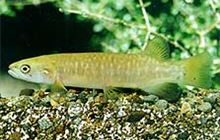Whitebaiters reminded to follow the rules as season begins
Archived content: This media release was accurate on the date of publication.
Introduction
DOC is reminding the public to be aware of the whitebait regulations with the commencement of the 2015 season.Date: 10 August 2015
The whitebaiting season runs from the 15 August until the 30 November everywhere except the West Coast of the South Island, which runs from the 1 September to the 14 November.
DOC Freshwater Ranger, Matt Brady says the regulations were put in place to allow fishing but also to act as a conservation measure to protect the 5 species whose juveniles contribute to the fishery.
“The whitebait species are iconic and fascinating. Many New Zealanders enjoy whitebait fishing as a recreational activity” Matt said. “However, most people agree that whitebait numbers have declined over the years.”
“It is encouraging, then, to see an increased interest and willingness to fence and plant spawning and adult whitebait habitat. In Hawke’s Bay a considerable length of river has been fenced off but there is always room for more protection. Whitebait fishers and others can also help by calling their local DOC or Regional Council office if they see overhanging culverts that stop whitebait migrating,” he says.
DOC staff will be out patrolling fishing sites and talking to fishers to check they are abiding with the Whitebait Regulations. The public are reminded that fishing is permitted between 5 am and 8 pm or between 6 am and 9 pm when daylight saving comes into effect.
“Illegal fishers can be fined up to $5,000 for certain offences so the public are urged to make themselves aware of what is permitted under the regulations,” Matt says.
DOC administers regulations regarding fishing methods, timing, location and net size to ensure that enough young fish get upstream to mature and subsequently create new whitebait for the future.
Pamphlets outlining information on the regulations can be obtained from DOC offices and sports shops and on the DOC website.
Background
New Zealand has nearly 40 native fish species. The small fish caught each spring by whitebaiters all around the country are actually the juveniles of five species of fish - giant kokopu, banded kokopu, shortjaw kokopu, inanga, and koaro. These five are part of a group of fish called galaxiids (so called because of the patterns of their skin which look like a galaxy of stars) of which there are 20 species, the rest of which don't migrate.
Those that escape the whitebait net grow into silvery, slender adults (about 9 cm long). They spawn in streamside vegetation, even rank exotic grasses are suitable.
Although galaxiid species are found in many places in the Southern Hemisphere, the giant, shortjaw and banded kōkopu only exist in New Zealand.
Our galaxiids are generally nocturnal and very good at hiding. They love bushy streams, where they find both shelter and food, with a rain of insects falling from the overhanging plants.
The main breeding season for our galaxiids is autumn. Inanga migrate downstream to estuaries and lay their eggs among plants and grasses, whereas kōaro and kōkopu stay where they are and lay their eggs on leaf litter and forest plants.
The eggs stay out of water for several weeks, and need good plant cover to keep moist. They hatch when re-immersed, either by spring tides (for inanga) or floods (for kōaro and kōkopu). The larvae then float out to sea where they live and grow over winter, migrating back upstream as whitebait in spring.
As half of our fish species spend some part of their lives at sea, this means they need easy passage to get to and from their freshwater habitats.
Contact
Matt Brady, DOC Services Ranger
Napier Office
Mobile: + 64 6 834 4846
Email: mbrady@doc.govt.nz


